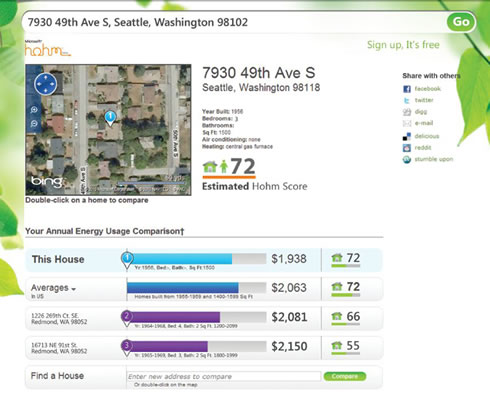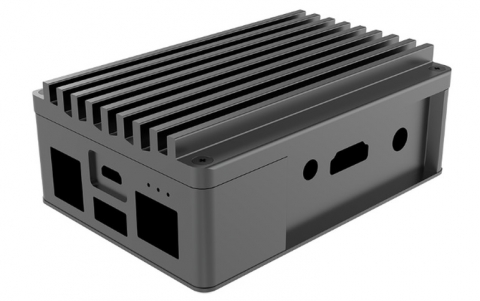
Microsoft Web site Ranks Your Home's Energy Efficiency
Microsoft is beefing up a a Web site aimed at helping people monitor their home energy use and pinpoint ways to cut costs.
Microsoft announced the availability of the Hohm Score, an estimate of a home's energy efficiency, offered as part of the company's free online home energy management tool, Microsoft Hohm. By simply typing in an address at http://www.microsoft-hohm.com, anyone can see the Hohm Score for almost any home in the United States.
Hohm Scores estimate the energy efficiency for more than 60 million United States homes. By entering a home address, anyone can compare their energy use to the average of other households in their neighborhood, or across the U.S.
 Hohm Scores are calculated using public record information about a home?s size, age and location. It then adds in data about typical weather patterns for that area, average utility bills, and more. Finally, Hohm Scores apply advanced analytics licensed from the Lawrence Berkeley National Laboratory and the U.S. Department of Energy. Those analytics help calculate a home's likely energy use. The end result is an assessment of a home?s energy use, ranking it on a 1-100 scale (100 being perfect energy efficiency).
Hohm Scores are calculated using public record information about a home?s size, age and location. It then adds in data about typical weather patterns for that area, average utility bills, and more. Finally, Hohm Scores apply advanced analytics licensed from the Lawrence Berkeley National Laboratory and the U.S. Department of Energy. Those analytics help calculate a home's likely energy use. The end result is an assessment of a home?s energy use, ranking it on a 1-100 scale (100 being perfect energy efficiency).
Hohm Scores can "learn" about a home to create even more detailed energy profiles. Online questions about heating habits, or home features such as storm windows or upgraded insulation, allow Hohm to fine-tune the score it assigns a house. Also, people living in the service areas of utility companies Seattle City Light, Sacramento (Calif.) Municipal Utility District, and Xcel Energy (eight states in the Midwest and West) can link their energy bills to a private Hohm page automatically. People outside these service areas can manually enter their energy use data. This allows Hohm to develop even more detailed rankings.
The payoff is that Hohm can then recommend ways to trim energy usage ? from simple things like caulking windows and using cold water to wash your clothes to bigger projects like adding insulation or replacing windows.

Hohm Scores are also social. Hohm users can log in using a secure password for access to a private profile page. But they also have the option to share any changes they make to their Hohm score with others to show how they are doing.
In addition to their usefulness as a household planning tool, Hohm and Hohm Scores also demonstrate the power of the cloud. Both are built using the Windows Azure platform, Microsoft's cloud-based computing platform that easily scales up to accommodate huge amounts of data and process it with super-computing resources. Azure also enables Hohm to collect and process information from a wide geographic area and millions of households.
The U.S. average Hohm Score comes in at 61, with Hawaii topping the list as having the highest average Hohm Score and with Texas coming in last. Here are the states with the highest and lowest Hohm Score averages:
Highest average Hohm Score
- Hawaii - 81
- Delaware - 70
- Maryland - 70
- District of Columbia - 68
New Jersey - 67
Lowest average Hohm Score
- 47. Arkansas - 53
- 48. Oklahoma - 52
- 49. Nevada - 51
- 50. Tennessee - 51
- 51. Texas - 51
Microsoft hopes Hohm will eventually make money from targeted ads on the site and by charging utilities for data about customers' energy usage.
Hohm Scores estimate the energy efficiency for more than 60 million United States homes. By entering a home address, anyone can compare their energy use to the average of other households in their neighborhood, or across the U.S.
 Hohm Scores are calculated using public record information about a home?s size, age and location. It then adds in data about typical weather patterns for that area, average utility bills, and more. Finally, Hohm Scores apply advanced analytics licensed from the Lawrence Berkeley National Laboratory and the U.S. Department of Energy. Those analytics help calculate a home's likely energy use. The end result is an assessment of a home?s energy use, ranking it on a 1-100 scale (100 being perfect energy efficiency).
Hohm Scores are calculated using public record information about a home?s size, age and location. It then adds in data about typical weather patterns for that area, average utility bills, and more. Finally, Hohm Scores apply advanced analytics licensed from the Lawrence Berkeley National Laboratory and the U.S. Department of Energy. Those analytics help calculate a home's likely energy use. The end result is an assessment of a home?s energy use, ranking it on a 1-100 scale (100 being perfect energy efficiency).
Hohm Scores can "learn" about a home to create even more detailed energy profiles. Online questions about heating habits, or home features such as storm windows or upgraded insulation, allow Hohm to fine-tune the score it assigns a house. Also, people living in the service areas of utility companies Seattle City Light, Sacramento (Calif.) Municipal Utility District, and Xcel Energy (eight states in the Midwest and West) can link their energy bills to a private Hohm page automatically. People outside these service areas can manually enter their energy use data. This allows Hohm to develop even more detailed rankings.
The payoff is that Hohm can then recommend ways to trim energy usage ? from simple things like caulking windows and using cold water to wash your clothes to bigger projects like adding insulation or replacing windows.

Hohm Scores are also social. Hohm users can log in using a secure password for access to a private profile page. But they also have the option to share any changes they make to their Hohm score with others to show how they are doing.
In addition to their usefulness as a household planning tool, Hohm and Hohm Scores also demonstrate the power of the cloud. Both are built using the Windows Azure platform, Microsoft's cloud-based computing platform that easily scales up to accommodate huge amounts of data and process it with super-computing resources. Azure also enables Hohm to collect and process information from a wide geographic area and millions of households.
The U.S. average Hohm Score comes in at 61, with Hawaii topping the list as having the highest average Hohm Score and with Texas coming in last. Here are the states with the highest and lowest Hohm Score averages:
Highest average Hohm Score
- Hawaii - 81
- Delaware - 70
- Maryland - 70
- District of Columbia - 68
New Jersey - 67
Lowest average Hohm Score
- 47. Arkansas - 53
- 48. Oklahoma - 52
- 49. Nevada - 51
- 50. Tennessee - 51
- 51. Texas - 51
Microsoft hopes Hohm will eventually make money from targeted ads on the site and by charging utilities for data about customers' energy usage.




















